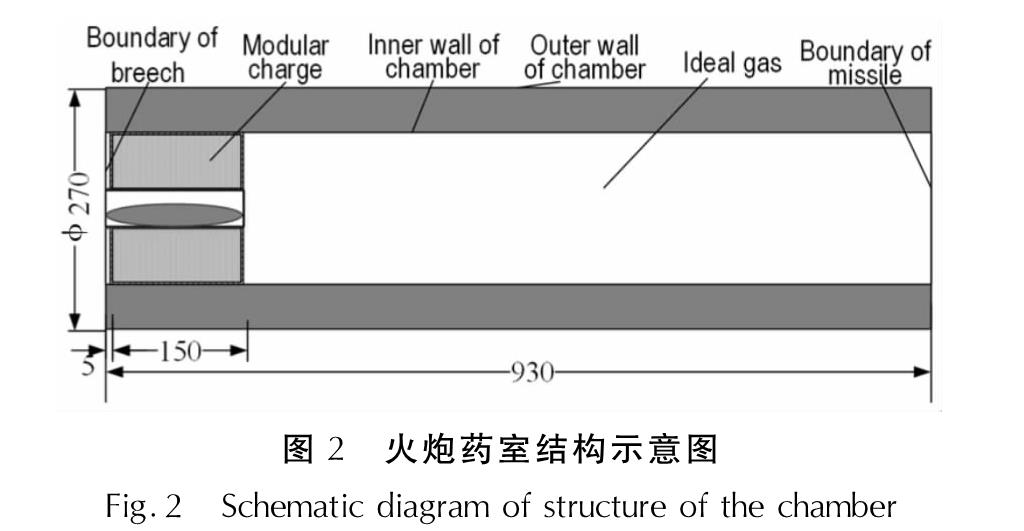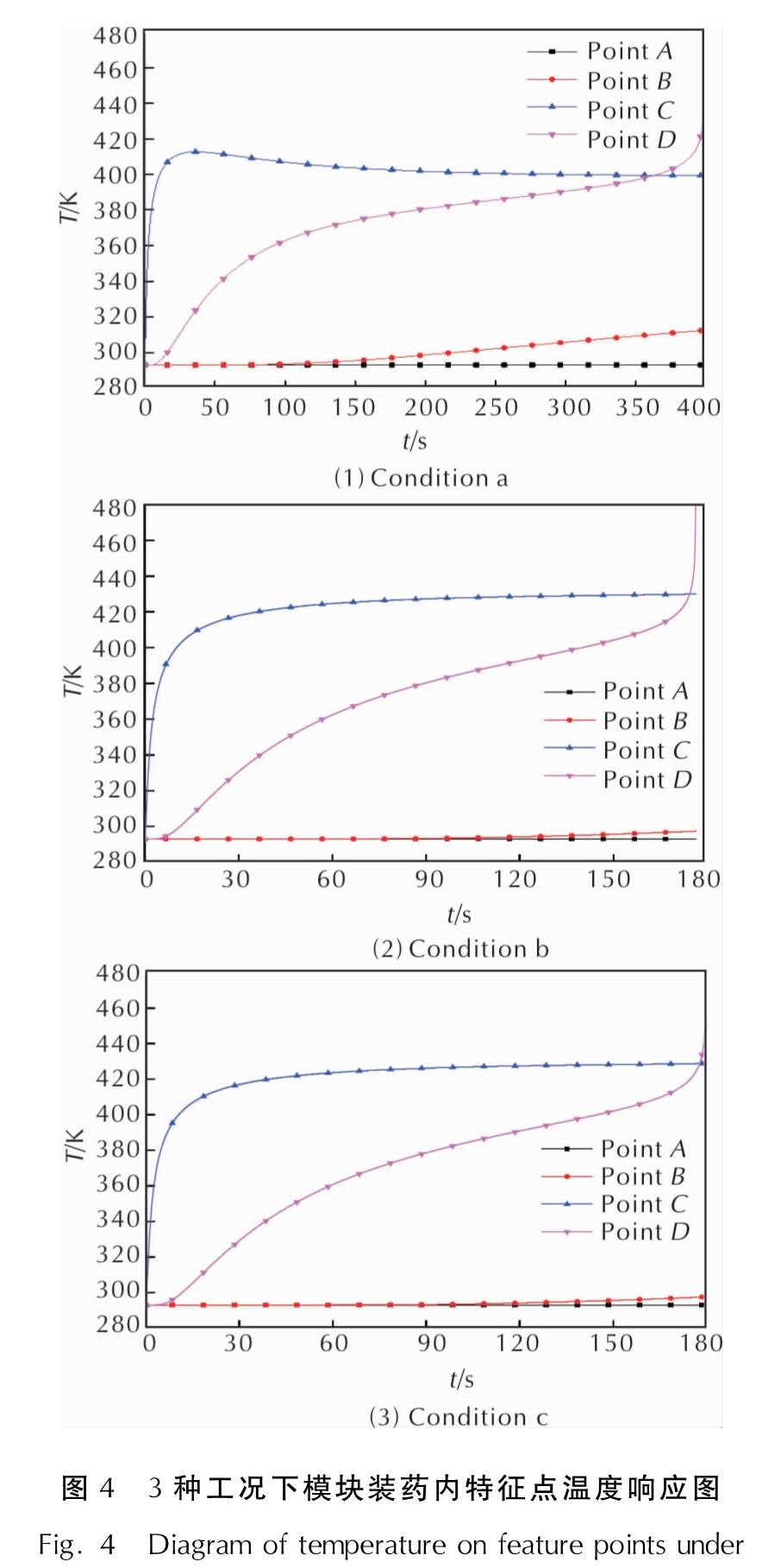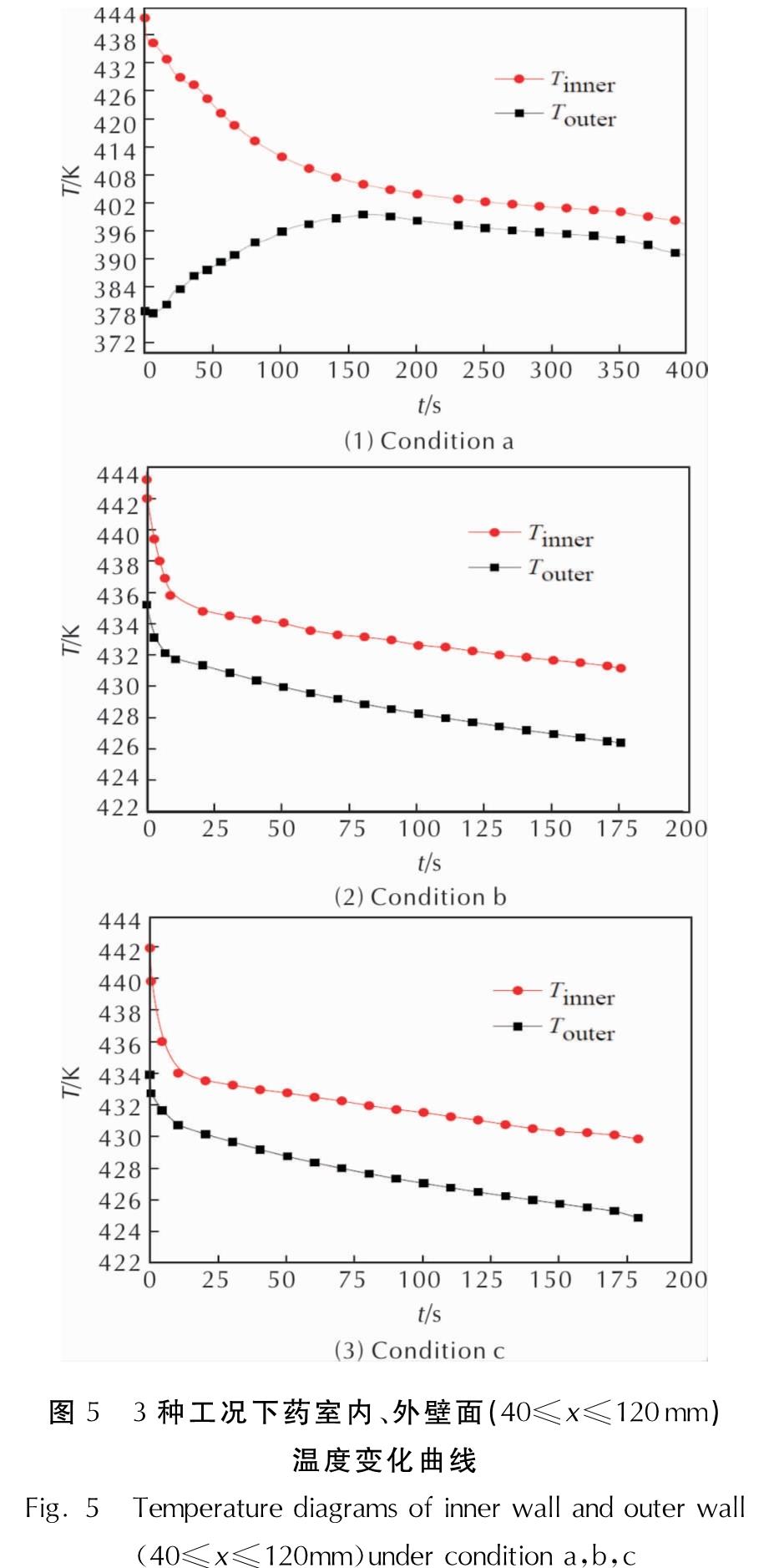作者简介:钱环宇(1994-),女,硕士研究生,从事模块装药热安全性研究。E-mail:huanyu_qian@163.com 通信作者:余永刚(1963-),男,教授,博士生导师,从事工程热物理研究。E-mail:yygnjust801@163.com
(1.南京理工大学能源与动力工程学院,江苏 南京 210094; 2.中国电子科技集团公司光电研究院,天津 300308)
(1.School of Energy and Power Engineering, Nanjing University of Science and Technology,Nanjing 210094, China; 2. Academy of Opto-electronic, China Electronics Technology Group Corporation,Tianjin 300308, China)
physical chemistry; gun propellant; modular charge; thermal safety; firing conditions; cook-off characteristics
DOI: 10.14077/j.issn.1007-7812.201904022
备注
作者简介:钱环宇(1994-),女,硕士研究生,从事模块装药热安全性研究。E-mail:huanyu_qian@163.com 通信作者:余永刚(1963-),男,教授,博士生导师,从事工程热物理研究。E-mail:yygnjust801@163.com
为研究火炮多发连续射击情况下模块装药滞留膛内的热安全性问题,建立了膛内模块装药二维非稳态烤燃模型,采用FLUENT软件对模块装药在膛内的烤燃过程进行了数值模拟,分析了3种射击工况下多发连续射击后继续装填模块装药留膛时的烤燃特性。结果 表明,常温下不同射击工况对膛内模块装药的烤燃响应时间影响较大,对烤燃起始响应位置影响较小,对烤燃响应温度几乎无影响; 采用5发/min射速射击32发后模块装药的烤燃响应时间为399.2s,采用1发/min射速射击43发和采用混合射速射击41发后模块装药的烤燃响应时间分别为176.4s和179.6s。3种射击工况下均是靠近模块盒右侧端面处的单基药最先着火,并形成环形烤燃响应区,单基药的烤燃响应温度分别为459.2、462.7和460.0K。
To study the thermal safety of modular charge in the artillery chamber after continuous fire rounds, a 2D unsteady state cook-off model of modular charge in the chamber was established. The cook-off process of modular charge in the chamber was numerically simulated by FLUENT software, and the cook-off response characteristics of modular charge reloaded in the chamber after three continuous firing conditions was analyzed. The results show that firing conditions have much influence on the cook-off response time of modular charge, while it has little influence on the initial cook-off response position and cook-off response temperature. The cook-off response time of modular charge is 399.2s under the condition of firing 32 rounds at 5 rounds/min, while response times are 176.4s and 179.6s under conditions of firing 43 rounds at 1 round/min and firing 42 rounds at a mixed firing speed. The initial ignition position is near the right end of the cartridge, where the single-base propellant is ignited first and an annular firing response zone is formed for all three conditions. The ignition response temperatures of single-base propellant are 459.2, 462.7and 460.0 K, respectively.
引言
模块装药是大口径加榴炮最有前景的一种装药方式,它具有装药刚性化、结构模块化等特点,便于火炮自动装填、实现高射速以及弹药智能勤务管理。然而在火炮连续射击过程中,药室内壁受到高温火药燃气的热冲击,温度不断升高,此时若继续装填模块装药,在高温壁面作用下,模块装药可能发生热自燃,出现热安全性事故。
近年来,国内外学者通过试验和数值模拟方法,开展了大量的弹药系统热安全性问题研究,主要涉及炸药和推进剂等含能材料。郑朝民等[1]通过推进剂热爆炸试验证明了采用热爆炸临界温度可评价火药装药安全性,并得出了合适的试验条件; Daniel等[2]利用CFD软件进行三维模拟,研究了不同升温速率下RDX、HMX、TNT等炸药的热稳定性及其对热刺激的响应; Aydemir[3]利用慢速烤燃装置研究了炸药PBCN-110的热安全性,得出了PBCN-110的烤燃响应时间、烤燃响应位置及烤燃响应温度; Yang等[4]研究了不同火焰环境下固体火箭发动机的热安全性问题,发现在800、1000和1200K火焰环境下推进剂AP/HTPB的初始着火位置基本相同,火焰温度升高则着火延迟期缩短、着火温度增大; Li等[5]为研究底排弹药的热安全性,建立了底排装置二维非稳态烤燃模型,结合不同烤燃速率,从装药长度和装药内孔直径两方面考察了装药尺寸对底排装置烤燃响应特性的影响; 陈晨等[6]用烤燃实验装置研究了双芳-3发射药的热安全性,得到双芳-3的点火温度和活化能,并发现环境温度对双芳-3的自燃延滞期和剧烈程度影响较大; Zhang等[7]为评价含能化合物NNHT的热安全性,通过试验得出了NNHT热分解反应动力学方程以及NNHT在不同升温速率下的化学反应动力学参数; Pourmortazavi等[8]采用差式扫描量热法和热重法对4种不同含氮量的硝化棉进行了热安全性研究,结果表明硝化棉的主要热解温度为192~209℃,分解温度随含氮量的增加而降低; 刘静等[9]在外界升温速率为1~10K/min的条件下分析了模块装药的快速烤燃响应特性,结果表明随着升温速率的提高模块发生烤燃响应的着火时间呈指数型衰减,而起始着火位置和着火响应温度变化不大。
现有研究中大多都只考虑了可控恒定升温速率下炸药、推进剂等材料可能出现的热安全性问题。而在实际的火炮多发连续射击过程中,膛内温度场复杂多变,装药入膛后发射药处于温升不恒定的烤燃环境,在这种动态的、温度变化剧烈的情况下,对发射装药的热安全性,尤其是模块装药的热安全性研究较小。对此,本研究以某155mm火炮为对象,建立模块装药膛内二维非稳态烤燃模型,针对3种射击工况,数值分析火炮多发连续射击后,继续装填模块装药时的热安全性问题。
1 物理模型
模块装药结构示意图如图1所示。模块盒由可燃材料制成,呈薄壁圆筒状,盒内装填单基药。模块装药内设中心传火管,管内放置蛇形点火药袋,两端用纸质挡板密封。模块盒壁厚2.5mm,中心传火管壁厚2.5mm,纸质挡板厚0.5mm。火炮药室结构示意图如图2所示。药室近似为等壁厚圆筒,模块装药位于药室左侧,与膛底边界间隙为5mm,模块盒外壁面与环形药室内表面相接触,忽略两者的间隙。
火炮连发射击后装填模块装药。由于连发射击过程热量积累,药室壁面温度不断升高,模块装药装填到位后随即开始烤燃过程。取火炮药室及内部的模块装药为研究对象,其中火炮药室为高温热源。在此后的传热过程中,考虑4个方面的热量传递:(1)高温药室壁面与模块装药之间的接触导热;(2)高温药室内壁面与药室内气体之间的对流换热;(3)高温药室外壁面与外界环境之间的对流换热;(4)药室内气体(包括中心传火管内气体)与模块装药之间的对流换热。不考虑热辐射及药室左右两侧的热作用。
综合考虑火炮连发射击过程以及火炮和模块装药的结构特点,建立膛内模块装药二维非稳态烤燃模型,并采用如下简化假设:
(1)可燃模块盒及盒内单基药(含氮量12%)的热分解反应遵循Arrhenius定律且不考虑相变,认为在着火前均保持固态;
(2)模块盒和单基药分别作为均质、各向同性的材料处理;
(3)材料的物性参数和化学动力学参数在烤燃过程中保持不变;
(4)模块装药处于密闭药室内,膛内空气为理想气体;
(5)单基药在模块盒内均匀分布,并用多孔装药描述盒内单基药和空气的混合状态;
(6)假设模块装药与环形药室内壁接触导热,与两端的空气存在对流换热,忽略金属内壁的热辐射和炮闩的热作用;
(7)不考虑点火药包的热作用及其对气体流动的影响。
2 数学模型
3 计算模型
运用计算流体力学软件FLUENT对模块装药在膛内的烤燃过程进行了数值模拟。对此二维轴对称问题采用1/2结构模型进行计算。采用四边形结构网格划分计算域,并对边界处和交界面区域进行网格局部加密,共计334050个网格单元,并经过网格无关性验证。通过用户自定义函数(UDF)引入公式(3)和(4)的能量方程源项。求解时选择基于压力的求解器,压力—速度耦合采用SIMPLE模式,密度、压力、动量和能量方程均采用二阶迎风格式。时间步长取0.1s,并经过时间步长无关性验证。
计算模型如图2所示(单位:mm)。计算所用模块装药的动力学参数[6,12-14] 如表2所示,模块装药及火炮药室的物性参数[6,12-15] 如表3所示。
为了更直观地了解烤燃过程中模块装药内部各点处的温度响应,计算时在模块内设置特征点A、B、C为温度监测点,如图1所示。在坐标系(x,r)(单位:mm)中,A(75,52.5)点为模块盒内单基药的中心位置,B(75,72.5)点在A点的正上方,C(149.5,84.5)点在模块盒的内壁处。图中的D点为通过数值计算求解得`出的烤燃响应中心,即最先发生烤燃的位置,首次计算完成后D点的坐标方能确定。再将计算所得的D点位置设监测点,再次进行计算,以求解烤燃响应中心的温度特征。
计算认为,若某一时刻某点的温升曲线出现陡升,温度在瞬间急剧升高至1000K以上,则该点为烤燃响应中心,该温升曲线拐点对应的温度值为烤燃响应温度,拐点对应的时间为烤燃响应时间。
4 计算结果与分析
按照表1所示药室内外壁面的初始温度,分别针对工况a、b、c多发连续射击后,继续装填模块装药留膛时的烤燃过程进行数值模拟。
图3为工况a、b、c在不同时刻模块的温度分布云图。现以工况a为例进行分析。由图3(a)可知,在烤燃初始阶段(t=16.1s),模块盒外壁面因与高温药室内壁接触,温度不断升高,热量逐渐向模块盒内传递。模块盒左端面靠近火炮膛底,间隙内的气体在药室内壁、模块盒左端面和火炮膛底之间通过自然对流方式进行传热。火炮膛底初始温度与模块的初始温度相同,加之间隙较小,三者间几乎无热量传递,因此模块盒左端面处无温度梯度。药室内气体从药室内壁获得热量温度升高,再将热量传给位于药室左端的模块,因此模块盒右端面处温度逐渐上升。中心传火管内自传火管右端口向管内方向,原先温度较低的气体逐层被膛内的高温气体加热。
在烤燃中间阶段(t=300.1s),模块盒外壁面和右端面的温度继续升高,热量自外而内逐渐向模块盒内的单基药传递,靠近模块盒内壁面和右端面处的单基药温度不断升高,并进行缓慢的自热反应向内层的单基药传热。因模块盒的导热系数大于室内气体,故模块盒外壁面处的温升高于模块盒右端面处,中心传火管内壁面处的温度略高于管中心处。这一阶段缓慢传热,持续时间较长。
当t=399.2s时模块发生烤燃响应。烤燃起始响应位置在靠近模块盒右侧端面处,此处的单基药最先着火,形成环形着火响应区并迅速扩大,之后整个模块装药开始燃烧。结合t=300.1s的温度云图可知,位于起始着火位置的单基药同时受到来自模块盒外壁面和模块盒右端面两个方向的传热,且单基药的比热容小于模块盒的比热容,故接收同等热量时单基药的温升更高; 单基药的密度大于模块盒,热量不易散失,使得自热反应与热量累积相互促进。随着烤燃过程的进行,靠近模块盒右侧端面处的单基药温度持续升高且温升速率越来越快,形成高温区,直至t=399.2s时温度达到单基药的着火温度而发生烤燃响应。工况a的烤燃响应中心环形区坐标(x,r)约为(145.6,81.6)mm。
由图3的温度云图可知,工况b、c下模块烤燃过程与工况a类似,数值模拟结果基本相同:烤燃响应中心环形区的坐标分别为(146.4,82.1)mm、(146.3,82.1)mm,均是靠近模块盒右侧端面处的单基药最先着火,并形成环形着火响应区。烤燃响应时间相差不大。
图4为不同时刻3种工况下模块内A、B、C、D(见图(1))各点的温度响应图,表4所列为3种工况的烤燃结果。结合表3和图4可知,a、b、c 3种连发射击工况下模块装药的烤燃响应温度分别为459.2、462.7和460.0K,烤燃响应时间分别为399.2、176.4和179.6s,在1%误差允许范围内,3种工况的烤燃响应环形区坐标相同。
图5为烤燃过程中各工况对应的药室内外壁面温度变化曲线。因温度沿身管方向分布不均匀,故取x在[40,120]mm范围内(模块装药位置:0≤x≤150mm)较为恒定的温度值。结合数值模拟的初始条件可知,3种工况各自的内外壁初始温差分别为ΔTa =62.8K、ΔTb =8K、ΔTc =8K; 工况a的初始内壁温度与工况b、c之差ΔTinner≤1.6K,初始外壁温度之差ΔTouter≈56K。对于工况a,随着烤燃过程的进行,火炮药室内壁面向周围传热,温度不断下降; 外壁面温度先缓慢升高,当烤燃过程进行至烤燃中间阶段时,内外壁面温差较为恒定,此后药室外壁温度持续下降。工况b和c的药室内外壁面温度均持续下降且温差较为恒定。综合分析图3、图4和图5可知,3种工况之间烤燃响应时间、烤燃响应温度以及烤燃响应中心位置的差异是药室的初始内外壁温差导致的。药室初始内外壁温度对烤燃响应时间影响最大,对烤燃响应位置影响较小, 对烤燃响应温度几乎无影响。工况a的初始内外壁温差较大,这一温差直接导致了壁面传热、热量累积、膛内气体对流以及温升变化等差异,故工况a的烤燃结果与工况b和c有差异:其他条件相同时,工况a的烤燃响应时间较长,发生起始烤燃响应的位置与b和c大致相同,烤燃响应中心向模块盒右端面和单基药内部略有移动。
图5 3种工况下药室内、外壁面(40≤x≤120mm)温度变化曲线
Fig.5 Temperature diagrams of inner wall and outer wall(40≤x≤120mm)under condition a,b,c根据文献[16]试验结果可知,单基药的着火温度为443~463K。本研究针对a、b、c三种工况数值模拟所得模块盒内单基药的着火温度为459.2~462.7K,在试验所得结果范围内,验证了数值计算的正确性。
5 结 论
(1)对某155mm火炮连发射击后继续装填模块装药留膛时的烤燃过程进行数值模拟。结果表明,不同工况对烤燃响应时间影响较大,对烤燃起始响应位置影响较小,对烤燃响应温度几乎无影响。火炮以5发/min射速射击32发后,模块装药的烤燃响应时间为399.2s; 采用1发/min射击43发后和采用混合射速射击41发后,模块装药的烤燃响应时间分别为176.4s和179.6s。在此3种连发射击工况下,模块装药的烤燃响应温度分别为459.2、462.7和460.0K。
(2)3种工况下均是靠近模块盒右侧端面处的单基药最先着火,并形成环形着火响应区。采用1发/min射击43发后和采用混合射速射击41发后,模块装药的烤燃响应中心位置基本相同,而采用5发/min射速射击32发后模块装药的烤燃响应中心位置则稍微向模块盒右端面和单基药内部移动。在1%误差允许范围内,烤燃响应环形区的坐标(x,r)为(145,82)mm。
2.1 基本方程2.1.1 动力学方程模块盒和单基药的热分解均考虑一步反应机理。由Arrhenius定律和质量作用定律可知,模块盒和单基药的化学反应速率W1和W2分别为:
W1=A1exp(-E1/RT)ρ1(1)
W2=A2exp(-E2/RT)ρ2(2)
式中:A1、A2为指前因子,s-1; E1、E2为化学反应活化能,kJ/mol; ρ1、ρ2为密度,kg/m3; R为气体摩尔常数,R=8.314J/(mol·K)。
2.1.2 固相能量方程模块盒:
ρ1c1(∂T)/(∂t)=(λ1)/r[∂/(∂r)(r(∂T)/(∂r))+∂/(∂x)(r(∂T)/(∂x))]+W1Q1(3)
多孔装药:
ρ3c3(∂T)/(∂t)=(λ3)/r[∂/(∂r)(r(∂T)/(∂r))+∂/(∂x)(r(∂T)/(∂x))]+W2Q2(4)
其中多孔装药的ρ3、c3、λ3计算方法[10]如下:
{ρ3=(1-ε)ρ2+ερ4
c3=[(1-ε)ρ2c2+ερ4c4]/ρ3
λ3=(1-ε)λ2+ελ4(5)
火炮药室:
ρ5c5(∂T)/(∂t)=(λ5)/r[∂/(∂r)(r(∂T)/(∂r))+∂/(∂x)(r(∂T)/(∂x))](6)
式中:i=1、2、3、4、5分别表示模块盒、单基药、多孔装药、空气、火炮药室; ρi、ci、λi分别为材料的密度、比热容和导热系数,kg/m3、J/(mol·K)、W/(m·K); ε为多孔装药的孔隙率; Q1、Q2分别是模块盒和单基药的反应热,kJ/kg。
2.2 边界条件与初始条件给出求解方程(3)、(4)、(6)的边界条件如下,各相邻区域固相交界面(包括药室内壁面与模块盒外壁面、模块盒内壁面与盒内装药外壁面)满足温度连续和热流连续条件:
Tmr=rm=Tnr=rn(7)
Tmx=xm=Tnx=xn(8)
λm(∂Tm)/(∂r)r=rm=λn(∂Tn)/(∂r)r=rn(9)
式中:下标m和n表示任意交界面处相邻的两种固体材料。
火炮药室内壁面与药室内气体对流换热:
λ5((∂T)/(∂r))in=(hΔT)in(10)
火炮药室外壁面与外界环境对流换热:
λ5((∂T)/(∂r))out=(hΔT)out(11)
模块装药与药室内气体对流换热:
λ1((∂T)/(∂r))1=(hΔT)1(12)
药室左右两侧的膛底边界和弹底边界均为绝热边界。
计算域初始压强为标准大气压,初始温度为293K。在此环境下考虑3种射击工况:(a)以5发/min持续射击32发;(b)以1发/min持续射击43发;(c)混合射速射击41发——第一阶段,以5发/min持续射击3min; 第二阶段,以3发/min持续射击5min; 第三阶段,以1发/min持续射击。
文献[11]按以上3种工况射击直至药室内壁温度达到约170℃,将此药室内外壁温度作为模块装药烤燃的初始条件,3种工况的内外壁温度如表1所示。
表1 不同射击工况下的药室内外壁初始温度[11]
Table 1 Initial temperature of inner /outer wall under different firing conditions[11]- [1] 郑朝民, 王琼, 丁黎, 等. 用热爆炸临界温度评价火药装药热安全性的试验方法[J]. 含能材料,2015,23(6):548-552.
- [2]ASANTE D O, KIM S, CHAE J, et al. CFD cook-off simulation and thermal decomposition of confined high energetic material[J]. Propellants,Explosives,Pyrotechnics, 2015, 40(5):699-705.
- [3]AYDEMIR E, ULAS A, SERIN N. Thermal decomposition and ignition of pbxn-110 plastic-bonded explosive[J]. Propellants, Explosives, Pyrotechnics, 2012, 37(3):308-315.
- [4]YANG H W, YU Y G, YE R, et al. Cook-off test and numerical simulation of AP/HTPB composite solid propellant[J]. Journal of Loss Prevention in the Process Industries, 2015, 40(2016):1-9.
- [5]LI W F, YU Y G, YE R. Effects of charge size on slow cook-off characteristics of AP/HTPB composite propellant in base bleed unit[J]. Propellants, Explosives, Pyrotechnics, 2018, 43(4):404-412.
- [6]陈晨, 路桂娥, 江劲勇, 等. 双芳-3发射药热安全性的实验研究[J]. 火炸药学报, 2014, 37(3):70-73.
- [7]ZHANG J Q, GAO H X, MA H X, et al. Non-isothermal decomposition kinetics, heat capacity, and thermal safety of 2-nitroimino-5-nitro-hexahydro-1,3,5-triazine[J].Propellants, Explosives, Pyrotechnics, 2011, 36(1):28-33.
- [8]POURMORTAZAVI S M, HOSSEINI S G, RAHIMI-NASRABADI M, et al. Effect of nitrate content on thermal decomposition of nitrocellulose[J]. Journal of Hazardous Materials, 2009, 162(2/3):1141-1144.
- [9]刘静,余永刚. 模块装药快速烤燃特性的数值预测[J]. 含能材料, 2019, 27(5):25-30.
- [10]刘伟, 范爱武, 黄晓明. 多孔介质传热传质理论与应用[M]. 北京:科学出版社, 2006.
- [11]陈桂东, 周彦煌. 火炮身管报警温度的确定[J]. 兵工学报, 2008, 29(1):19-22.
- [12]胡荣祖,郭鹏江,宋纪蓉,等. 用非等温DSC估算硝化棉热爆炸的临界温升速率[J].火炸药学报, 2003, 26(2):53-57.
- [13]姚二岗, 胡荣祖, 赵凤起, 等. 用DSC曲线数据估算硝化棉的CnB和表观经验级数自催化分解反应热爆炸临界温升速率[J]. 火炸药学报, 2013, 36(5):72-76.
- [14]宁斌科, 刘蓉. 硝化棉一级自催化分解反应动力学参数数值模拟[J]. 含能材料, 1999, 7(4):162-165.
- [15]张明安. 火炮身管工作过程传热模拟[M]. 北京:兵器工业出版社,2016.
- [16]刘子如. 含能材料热分析[M]. 北京:国防工业出版社,2008.


![表1 不同射击工况下的药室内外壁初始温度[11]<br/>Table 1 Initial temperature of inner /outer wall under different firing conditions[11]](2020年02期/pic162.jpg)






